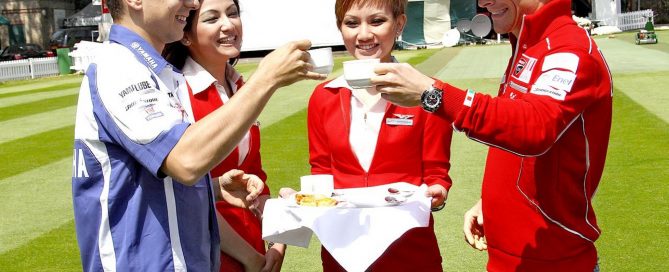Such a long way from home
How ironic that the Kiwi emblazoned on Hugh Anderson’s iconic pudding basin helmet represented a flightless bird from his native New Zealand. Flightless is the very last word to describe Anderson and his fellow countryman’s globe spanning journeys in search of World Championship glory in Europe.
Of course, Anderson is the best known and his induction into the MotoGP™ Hall Of Fame was not only to celebrate his considerable achievements but to all of those New Zealand riders who sacrificed so much to make such a long journey.
Anderson was not the first or the last but his impact was enormous. He was the true talisman who brought success to a proud country a long way from Europe. He is the only New Zealand rider to win a World title with those two 125 a two 50cc Championships for Suzuki. Anderson scored 25 of the 31 Grands Prix wins by New Zealand riders and no other rider has achieved more Grands Prix wins for Suzuki. Those 25 wins for the Japanese factory have only been equalled by 500cc World Champion Kevin Schwantz.
A decade earlier those pioneering globe trotters arrived from the other side of the World and won Grands Prix. The first New Zealand winner was Ken Mudford who gave Norton success in the 350cc 1953 Ulster Grand Prix. A year later Rod Coleman brought AJS their last Grand Prix with victory in the 350cc race at the TT on route to third place in the World Championship. Ginger Molloy was rewarded for his tireless pursuit of the multi-cylinder Japanese machine with a win at the 1966 Ulster Grand Prix on the 250cc Bultaco. Thirteen years later Dennis Ireland took advantage of the top riders’ boycott of the re-surfaced Spa Francorchamps circuit to win the 500cc Belgium Grand Prix. Current Dorna pit lane reporter Simon Crafer dominated the 500cc race at the 1998 British Grand Prix to bring Yamaha their only win of the season and the last premier class victory on Dunlop tyres.
Some who made the journey paid the ultimate price and none more so than Kim Newcombe. A brilliant rider and engineer Newcombe produced a two-stroke 500cc engine from a West German flat-four König outboard boat engine. He lay second in the 1973 World Championship after winning in Yugoslavia on the Opatija road circuit. To fund his considerable Grand Prix efforts, he raced at a non-championship international event at Silverstone. In the race Newcombe hit an unprotected post at Stowe corner and died in hospital three days later.
I think being so far from home encouraged riders from Australia and even more so New Zealand to enjoy and make the most of paddock life. Two of them Stu Avant and Graeme Crosby were so typical to make the most of their adventure and I was happy to join in with them. I arrived to report on my first ever race at Misano in 1976. I was wandering round the paddock a lost, nervous soul when Stu Avant stopped me to tell his story. He’d arrived for his first race outside New Zealand with his friend Mike Sinclair. At last I was up and running with the story. I became great friends with Stu especially when he was based in England, although as an Oxford boy I could never agree of his support of our great football rivals from Reading.
Finally, while we celebrated with Hugh Anderson last week we also mourned the loss of another true great World Champion. Phil Read is surely the most underrated rider in the 74-year history of our sport. Seven World titles, 52 Grands Prix wins and the first rider to win 125, 250 and 500cc World titles.
A true Prince of Speed.


